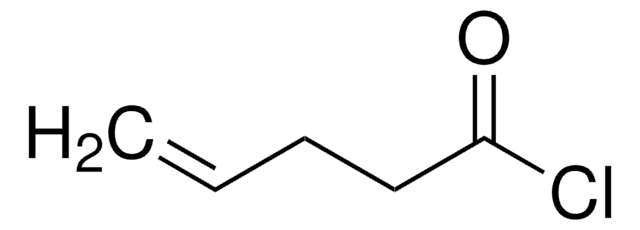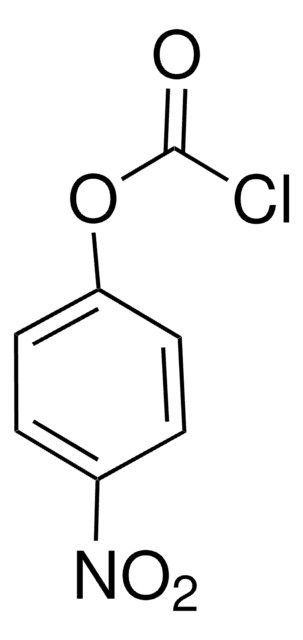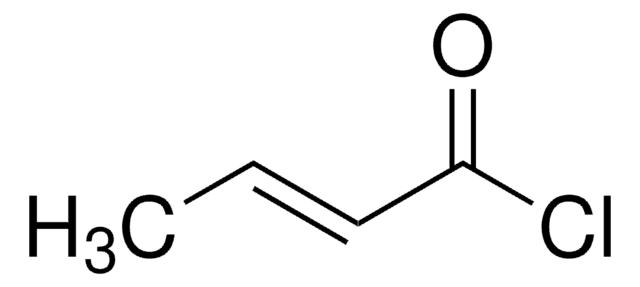おすすめの製品
蒸気密度
>1 (vs air)
品質水準
蒸気圧
1.93 psi ( 20 °C)
アッセイ
97.0%
含みます
<210 ppm MEHQ as stabilizer
屈折率
n20/D 1.435 (lit.)
bp
72-76 °C (lit.)
密度
1.114 g/mL at 25 °C (lit.)
保管温度
2-8°C
SMILES記法
ClC(=O)C=C
InChI
1S/C3H3ClO/c1-2-3(4)5/h2H,1H2
InChI Key
HFBMWMNUJJDEQZ-UHFFFAOYSA-N
類似した製品をお探しですか? 訪問 製品比較ガイド
詳細
Acryloyl chloride is a derivative of acrylic acid and is widely used as a reactive monomer in the synthesis of various polymers with desired properties such as good transparency, flexibility, excellent mechanical and thermal properties, and resistance to moisture and chemicals. Acryloyl chloride contains both an acryloyl group (-CH2=CHC(O)Cl) and a chloride functional group (-Cl) in its structure. This combination of functional groups enables acryloyl chloride to undergo polymerization reactions and participate in copolymerization processes. In the field of polymers, acryloyl chloride is commonly used in the production of acrylic polymers, such as polyacrylates and polymethacrylates. These polymers have a wide range of applications, including coatings, adhesives, sealants, textiles, and biomedical materials.
アプリケーション
Acryloyl chloride can used as a monomer in the synthesis of:
- Acrylic polymers via radical polymerization or copolymerization. These acrylic polymers can be tailored to possess the desired properties for biomedical coatings, including biocompatibility, adhesion to the device surface, and durability.
- Poly(styrene-co-acryloyl chloride) copolymer by crosslinked networks with styrene. The resulting crosslinked polymer can then be functionalized or modified by various chemical reactions to introduce specific properties or functionalities desired for the application as a polymer support or an electrophilic scavenger resin.
- Acrylamide-modified chitosan.
- Ulvan acrylate macromer via esterification of hydroxyl groups of polysaccharides. This macromer can be used to prepare ulvan-based thermosensitive hydrogels.
- Degradable peptide cross-linker by the acrylation of the amine groups of lysine residues and glutamine within peptide sequences.
シグナルワード
Danger
危険有害性情報
危険有害性の分類
Acute Tox. 1 Inhalation - Acute Tox. 4 Oral - Eye Dam. 1 - Flam. Liq. 2 - Met. Corr. 1 - Skin Corr. 1A
補足的ハザード
保管分類コード
3 - Flammable liquids
WGK
WGK 3
引火点(°F)
30.2 °F
引火点(℃)
-1 °C
適用法令
試験研究用途を考慮した関連法令を主に挙げております。化学物質以外については、一部の情報のみ提供しています。 製品を安全かつ合法的に使用することは、使用者の義務です。最新情報により修正される場合があります。WEBの反映には時間を要することがあるため、適宜SDSをご参照ください。
消防法
第4類:引火性液体
第一石油類
危険等級II
非水溶性液体
労働安全衛生法名称等を表示すべき危険物及び有害物
名称等を表示すべき危険物及び有害物
労働安全衛生法名称等を通知すべき危険物及び有害物
名称等を通知すべき危険物及び有害物
Jan Code
549797-VAR:
549797-BULK:
549797-500G:
549797-5G:
Soyeon Kim et al.
Biomacromolecules, 4(5), 1214-1223 (2003-09-10)
Hydrogels composed of N-isopropylacrylamide (NIPAAm) and acrylic acid (AAc) were prepared by redox polymerization with peptide cross-linkers to create an artificial extracellular matrix (ECM) amenable for testing hypotheses regarding cell proliferation and migration in three dimensions. Peptide degradable cross-linkers were
Andrea Morelli et al.
Carbohydrate polymers, 136, 1108-1117 (2015-11-18)
The present study is focused on the exploitation and conversion of sulphated polysaccharides obtained from waste algal biomass into high value added material for biomedical applications. ulvan, a sulphated polysaccharide extracted from green seaweeds belonging to Ulva sp. was selected
Iris Ben-David et al.
Applied radiation and isotopes : including data, instrumentation and methods for use in agriculture, industry and medicine, 58(2), 209-217 (2003-02-08)
An automated procedure for the radiosynthesis of the labeling synthon [11C]acryloyl chloride was developed and applied for labeling several N-acryl amides with carbon-11. [11C]-6-acrylamido-4-(3,4-dichloro-6-fluoroanilino)quinazoline (ML03), a novel PET biomarker targeting the epidermal growth factor receptor tyrosine kinase (EGFr-TK) in cancer
V Fulcrand et al.
International journal of peptide and protein research, 38(3), 273-277 (1991-09-01)
Copolymers of acrylated derivatives of alpha-chymotrypsin and polyethylene glycol (PEG) have been prepared and used as biocatalysts for the synthesis of model peptides in organic solvent containing a low quantity of water. Other peptide couplings have been tried to point
J C Tiller et al.
Proceedings of the National Academy of Sciences of the United States of America, 98(11), 5981-5985 (2001-05-17)
Poly(4-vinyl-N-alkylpyridinium bromide) was covalently attached to glass slides to create a surface that kills airborne bacteria on contact. The antibacterial properties were assessed by spraying aqueous suspensions of bacterial cells on the surface, followed by air drying and counting the
ライフサイエンス、有機合成、材料科学、クロマトグラフィー、分析など、あらゆる分野の研究に経験のあるメンバーがおります。.
製品に関するお問い合わせはこちら(テクニカルサービス)











